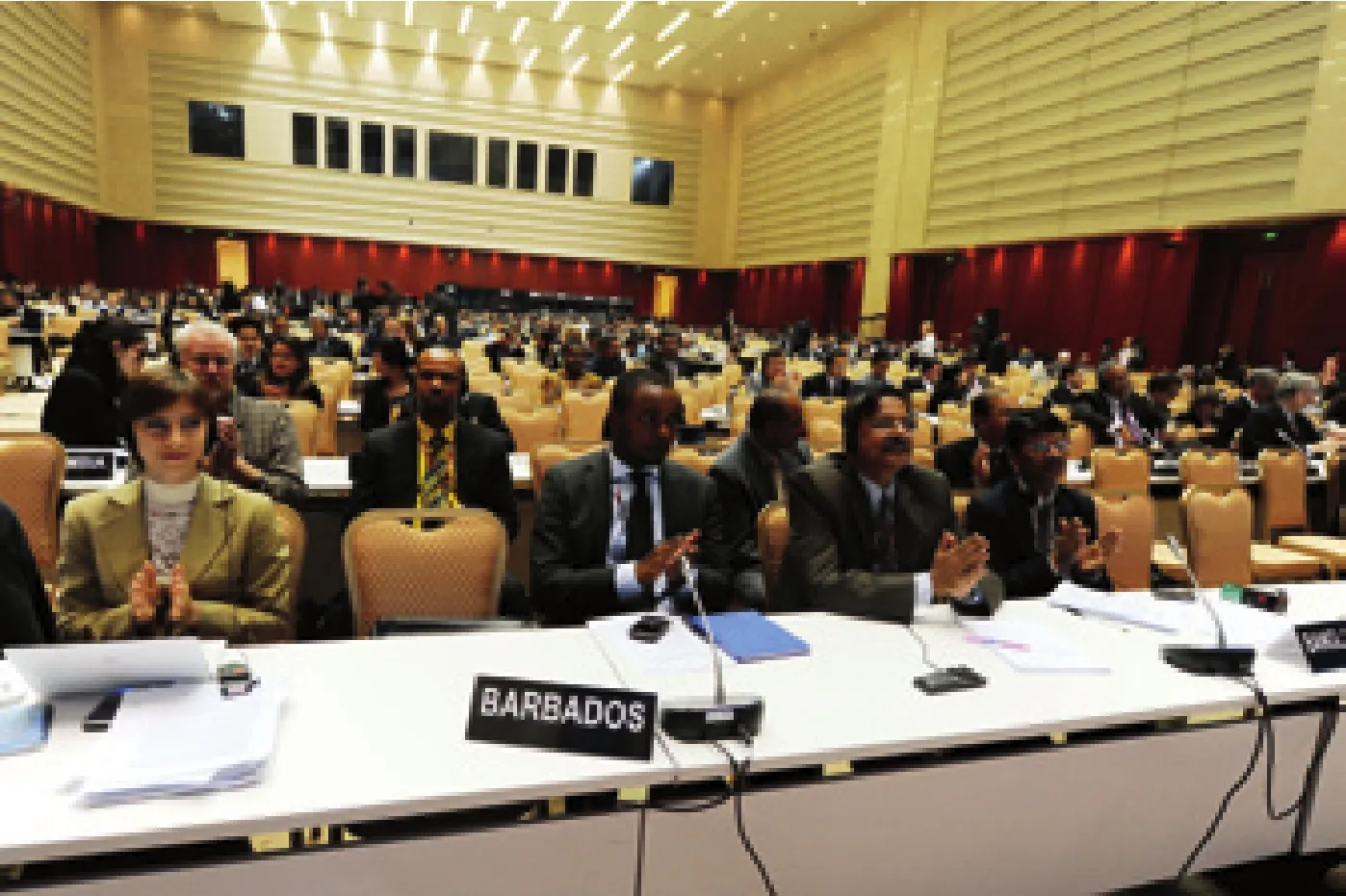Moving On
2010-10-14HUYUE
Moving On
By HU YUE
At the Tianjin conference, nations try to find common ground on climate change
A s global climate negotiators gathered in Tianjin, a port city of north China,they knew exactly what their decisions would mean for the world’s future.
Two special working groups under the UN Framework Convention on Climate Change (UNFCCC) and its Kyoto Protocol met side by side on October 4-9 to seek consensus.
The Ad Hoc Working Group on Long-Term Cooperative Action Under the Convention, comprising all 194 parties to the UNFCCC, was tasked to deliver a long-term global approach to the climate challenge. The Ad Hoc Working Group on Further Commitments for Annex I Parties Under the Kyoto Protocol met in parallel to discuss the emissions reduction commitments for the 37 industrialized countries that have rati fi ed the Kyoto Protocol for the period beyond 2012.
This was the fourth and last chance for negotiation this year in the run up to the climate summit to be held in Cancún, Mexico,from November 29 to December 10. The talks were designed to pick up on issues left unresolved at the Copenhagen summit last December and to pave the way for success in Cancún.
A global concern
For countries across the globe, combating climate change is not a matter of choice.Extreme weather events, like crippling mudslides in China, raging forest fi res in Russia and devastating storms in Pakistan, serve as reminders of the fact that human survival is already at stake. The question naturally arises: What is being done to avoid a runaway climate disaster?
Under the Kyoto Protocol, the 37 industrialized nations, not including the United States, are obliged to cut their greenhouse gas emissions 5.2 percent from 1990 levels. But the first commitment period of the protocol will expire in 2012,and a second commitment period needs to be fi nalized.
Last year’s Copenhagen summit ended without a legally binding agreement on emissions reduction, leaving major rifts between poor and rich nations unaddressed. The industrialized world pledged to cut emissions 10-20 percent by 2020 from 1990 levels, far short of what is needed to prevent catastrophic global warming. In its most recent report,the Intergovernmental Panel on Climate Change claimed a 25-40-percent cut in emissions from 1990 levels was necessary to halt global warming.

FIGHTING CLIMATE CHANGE: Delegates attend the last plenary session of the UN climate talks in north China’s Tianjin Municipality on October 9. The talks helped pave the way for the year-end climate summit in Cancún, Mexico
In Copenhagen, developed nations agreed to provide $30 billion from 2010 to 2012 to help their developing counterparts with climate change mitigation and adaptation. They would also boost the aid to$100 billion a year by 2020. However, as months have passed since the Copenhagen summit, it remains unclear how the aid should be used. Some developing countries have also questioned the legitimacy of some of the already-committed funds,saying they may have been transferred from other aid budgets and just “pasted with a climate label.”
The Tianjin conference was critical in allowing countries “to identify what is already ripe for adoption in Cancún, and what are those issues that require further conversation,” said Christiana Figueres, Executive Secretary of the UNFCCC.
Negotiators produced a draft decision text that will be submitted to the Cancún conference, and they came much closer to working out a new long-term fi nancing plan to cope with climate change, said Figueres.
She said less progress was made in discussions on the continuation of the Kyoto Protocol, but expressed confidence that the issue would make progress in Cancún.
Developed countries should take the lead in deep emissions cuts and climate fi nancing as they have the historical responsibility for climate change, Peter Muteyauli, a Namibian climate negotiator toldBeijing Review, on the sidelines of the conference.
In the past, rich nations have largely created the climate crisis, but it is poorer countries that are hit first and hardest, he said.
Instead, developed countries tried to shift the focus by calling for the participation of major developing economies such as China,India and Brazil. This is not in line with the principle of “common but differentiated responsibilities,” he said.
Lian Kok Fei, a negotiator from Malaysia, agreed. “Developing countries deserve some space for economic development, and their emissions reductions should be voluntary,” he said.
In fact, many developing countries,including China, are already making remarkable contributions and laying the groundwork for wider agreements, he said.
“If we are to make progress in our negotiations, we have to make sure our work is based on the principles and provisions of the convention [UNFCCC] and the Bali Action Plan,” said Ambassador Abdullah M.Alsaidi, head of the delegation of Yemen, in a statement on behalf of the Group of 77 and China.
In this regard, ideas and proposals that are inconsistent with these principles and provisions, such as the reclassification of countries and differentiation amongst developing countries, will impede the process, he said.
The BASIC, a group of large developing countries consisting of China, India,Brazil and South Africa, held a ministeriallevel meeting in Tianjin, right after the close of the weeklong UN climate talks. In a joint statement, the four nations urged developed countries to ful fi ll their obligations to help developing countries combat global warming.
China’s role
With those efforts in place, China is gearing up for an ambitious goal: cutting carbon dioxide emissions per unit of GDP 40-45 percent from 2005 levels by 2020. The country also hopes non-fossil fuels could account for 15 percent of its energy consumption and its forest coverage rate could reach 23 percent by 2020.
China will continue to play a “constructive role” in pushing forward the process of international climate negotiations, said Xie Zhenhua, Vice Minister of China’s National Development and Reform Commission.
“We are working actively with developing countries and have also established smooth dialogue channels with major developed countries,” said Xie.
He also noted that some developed countries are still attempting to apply tough standards on the voluntary efforts of developing countries to squeeze emissions. This runs against the principle of equality, he said.
Developed countries should shoulder their due responsibility as some 80 percent of the emissions accumulated on Earth were produced by them during the past 200 years,said Su Wei, China’s chief climate negotiator.
They should cut more emissions and leave more room for developing countries,which have yet to industrialize their economies and eradicate poverty, he added.
Industrialized countries are not making progress, but regressing and attempting to completely change the direction of the mandates for the Kyoto Protocol, Su said.
China and other developing countries firmly oppose actions that violate the protocol mandates and the Bali Road Map, he said.
由于工作速度较低,采用单滚子沟槽式平面凸轮机构可满足要求。凸轮槽焊接于左右支撑板上,结构如图2所示。滑板两侧的滚子可在两侧的凸轮槽内滚动,从而带动滑板在滑槽内上下运动。
The Bali Road Map, which includes the Bali Action Plan, was adopted at the UN climate conference in Bali, Indonesia, in 2007.
As a country of 1.3 billion people with a per-capita GDP ranking around 100th in the world, China faces the arduous task of growing the economy and improving people’s livelihoods, said State Councilor Dai Bingguo.
“At a stage of accelerated industrialization and urbanization, the country will experience further reasonable growth in demands for energy. That is why we will face significant constraints in controlling greenhouse gas emissions,” he said.
China will achieve its goal of emissions cuts by restructuring the economy, improving energy ef fi ciency, developing renewable energy and increasing forest carbon sink, he said.
The road ahead
Given the uncertainties surrounding the negotiations, it seems unlikely that a legally binding agreement to extend the Kyoto Protocol will be signed in Cancún.But negotiators are convinced that a successful outcome is within reach if the parties can rebuild trust and break the stalemate.
Cancún will only be another stepping stone to a substantive agreement, which is more likely to emerge at the 2011 summit in South Africa, said a negotiator of Switzerland, who asked to remain anonymous.
A more realistic approach for the Cancún summit is to move forward on a set of decisions such as climate financing, technology transfer, adaptation and deforestation, said Francesco Presicce, a negotiator of Italy.
The parties need more time to bridge differences and rebuild mutual trust, said Michele Stua, a researcher at the Sussex Energy Group, a UK nongovernmental energy policy research organization.
One reason for the current deadlock is that developed countries don’t understand the needs of their developing counterparts,he said.
The biggest difficulty is finding a balance between so many topics and interest groups, said Crispin d’Auvergne, a negotiator of Saint Lucia.
“But at least we are moving in the right direction as parties showed readiness to accelerate the negotiating process in Tianjin,”he said.
“The most important lesson learned from the Copenhagen summit is that you cannot build a tall building without setting foundations,” said Figueres.
Countries need to identify what the “cornerstones” for the foundations are and work toward an agreement on each, she said.
Figueres said there is a growing convergence in negotiations, and Cancún could deliver a balanced package of decisions that de fi ne the pillars of action to address climate change.
Such a politically balanced package of decisions could include a new global framework to help countries adapt to the already inevitable changes to the climate,the launch of a new mechanism to drive faster deployment of technology to developing nations, a decision to establish a new fund to oversee the long-term money raised for the speci fi c climate needs of developing nations, and a decision on early and large-scale action to protect forests and the livelihoods of those who live in them, she said.
(Reporting from Tianjin)
China’s Actions Against Climate Change
● China has a fi rm handle of industries that consume large amounts of energy and cause severe pollution. Between 2006 and 2010, it has shut down 60 gigawatts of thermal power generating units, and has phased out 60.38 million tons of backward steel-making capacities and 214 million tons of inef fi cient cement-making capacities.
● In 2009, China’s installed capacity of wind power more than doubled from the previous year, hitting 25 gigawatts. The country’s installed capacity of hydropower was 200 gigawatts, the largest in the world, by August 2010.
● In June 2010, the Chinese Government announced subsidies to new energy vehicles. Based on the capacity of the battery packages, a 3,000-yuan ($439) subsidy is offered for each kilowatt-hour for green cars, with a cap of 50,000 yuan ($7,322) for each plug-in hybrid car and 60,000 yuan ($8,784) for each pure electric car.
● China has strengthened efforts to promote green industries such as new materials,environmental protection, the service industry and information technology.
Source:National Development and Reform Commission of China
